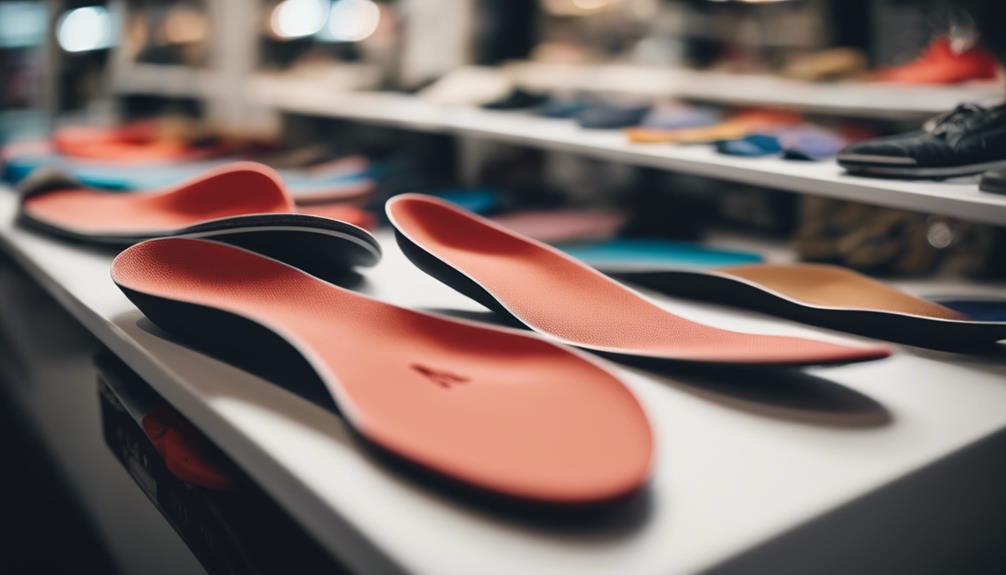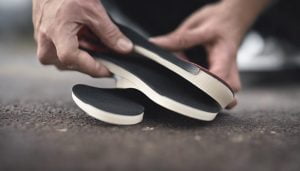This post contains affiliate links. As an Amazon Associate, we earn from qualifying purchases.
Choosing the right insole is a crucial decision that can greatly impact your overall foot comfort and health. With various factors to consider like foot arch type, cushioning needs, and material composition, the process can seem overwhelming.
However, by understanding the key components of selecting an insole tailored to your unique requirements, you can ensure optimal support and functionality. Stay tuned to uncover essential tips and guidelines that will lead you to the perfect insole match for your feet, allowing you to stride comfortably with every step.
Key Takeaways
- Determine your foot arch type to select the right support level.
- Consider your activity level and shoe compatibility for optimal comfort.
- Choose materials like memory foam or gel for customized cushioning.
- Test insole fit inside shoes for stability and consult specialists for personalized advice.
Insole Types and Functions
Exploring the diverse range of insole types and their specific functions is essential for selecting the most suitable option to address individual foot care needs effectively.
Insoles play a crucial role in providing support and comfort to the feet, with variations like cushioned arch supports, orthotic arch supports, and flat cushions catering to different requirements.
Cushioned arch supports are designed to alleviate foot fatigue, while orthotic arch supports aid in foot alignment and help with conditions like plantar fasciitis. These insoles offer targeted support to the arch, heel, and overall foot structure, ensuring a proper fit inside the shoe.
Understanding the functions of various insole types is vital for managing foot conditions and enhancing overall foot health.
Considerations for Choosing Insoles
When selecting insoles, it is crucial to consider various factors to ensure optimal support and comfort for your feet.
- Determine your foot arch type (low, medium, high) to choose the right level of support and cushioning in an insole.
- Assess your activity level and the type of shoes the insoles will be used in to ensure compatibility and effectiveness.
- Look for insoles made from materials like memory foam, gel, or heat-moldable options based on your comfort and support preferences.
- Check the fit of the insole inside your shoes after replacing the stock insole to ensure stability, support, and correct volume.
- Seek advice from a footwear specialist or use Insole Advisor features to get personalized recommendations tailored to your specific foot needs and conditions.
Material and Construction of Insoles

Insoles are crafted from a variety of materials and designed with specific constructions to offer support and comfort to the wearer's feet. Common materials used in insoles include foam, gel, leather, and wool, providing cushioning and stability.
Some insoles are heat-moldable, allowing for a customized fit to the wearer's foot shape. High-quality insoles may also incorporate features such as antimicrobial treatments to control odors and maintain hygiene.
The construction of insoles can include elements like arch support, heel cups, and metatarsal pads, which target specific areas of the foot to enhance comfort and stability. Varying in thickness and firmness, insoles cater to different foot conditions and preferences, ensuring optimal support for the wearer.
Signs It's Time to Replace Insoles
With continued use, insoles may exhibit visible signs of wear and tear, indicating the need for replacement to maintain optimal foot support and comfort. When it's time to replace your insoles, look out for these signs:
- Visible wear like flattening or thinning.
- Deterioration such as cracking, splitting, or loss of cushioning.
- Inadequate support or comfort provided by the insoles.
- Foot pain or discomfort while wearing footwear with the insoles.
- Regular inspection for any damage or decreased effectiveness to ensure continued foot support.
Recognizing these signs and promptly replacing worn-out insoles can help prevent foot pain and discomfort, ensuring your feet are properly supported with each step.
Steps to Find Your Perfect Insole

To ensure optimal foot support and comfort, it is essential to follow specific steps when selecting the perfect insole for your needs.
Start by determining your foot arch type (low, medium, high) to choose the right support level. Consider your activity level and the type of shoes you'll wear them in for compatibility.
Look for cushioning, arch support, and antimicrobial treatment based on your needs. Check the material (gel, memory foam) for comfort.
Test stability, support, and overall comfort by trying on different insoles and walking around before deciding.
Frequently Asked Questions
How Do I Know What Type of Insoles I Need?
To determine the appropriate insole type, consider your foot arch, cushioning preferences, foot conditions, activity level, and shoe compatibility. Seek professional guidance for specific foot issues. Proper insoles provide support, comfort, shock absorption, and align with your needs.
Do You Buy Insoles the Same Size as Your Shoe?
When purchasing insoles, it's essential to choose the same size as your shoe for a proper fit and comfort. Insoles can be trimmed to adjust to your shoe size, ensuring optimal support and cushioning while preventing discomfort or slippage.
What Are the Qualities of a Good Insole?
A good insole should provide adequate arch support, cushioning, durability, and moisture-wicking properties. Its design should match the foot's shape for optimal support and stability. Additional features like antimicrobial treatment or low-friction covers can enhance foot health and comfort.
How Do I Choose an Insole Size?
Selecting the right insole size is crucial for comfort and support. Match your shoe size with the corresponding insole size recommended by the manufacturer. Consider trying on the insole to ensure proper fit and opt for a slightly larger size if uncertain.
Conclusion
In conclusion, selecting the right insole is crucial for enhancing comfort and foot health. By considering factors such as foot arch type, cushioning needs, activity level, shoe type, and fit, you can choose an insole that provides the necessary support and functionality.
Pay attention to the materials and construction of the insole, and replace them when signs of wear and tear appear. Finding the perfect insole will improve your overall footwear experience.



